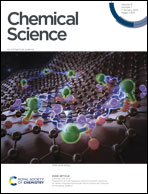Hydrogen spillover enhances alkaline hydrogen electrocatalysis on interface-rich metallic Pt-supported MoO3†
Abstract
Efficient and cost-effective electrocatalysts for the hydrogen oxidation/evolution reaction (HOR/HER) are essential for commercializing alkaline fuel cells and electrolyzers. The sluggish HER/HOR reaction kinetics in base is the key issue that requires resolution so that commercialization may proceed. It is also quite challenging to decrease the noble metal loading without sacrificing performance. Herein, we report improved HER/HOR activity as a result of hydrogen spillover on platinum-supported MoO3 (Pt/MoO3-CNx-400) with a Pt loading of 20%. The catalyst exhibited a decreased over-potential of 66.8 mV to reach 10 mA cm−2 current density with a Tafel slope of 41.2 mV dec−1 for the HER in base. The Pt/MoO3-CNx-400 also exhibited satisfactory HOR activity in base. The mass-specific exchange current density of Pt/MoO3-CNx-400 and commercial Pt/C are 505.7 and 245 mA mgPt−1, respectively. The experimental results suggest that the hydrogen binding energy (HBE) is the key descriptor for the HER/HOR. We also demonstrated that the enhanced HER/HOR performance was due to the hydrogen spillover from Pt to MoO3 sites that enhanced the Volmer/Heyrovsky process, which led to high HER/HOR activity and was supported by the experimental and theoretical investigations. The work function value of Pt [Φ = 5.39 eV) is less than that of β-MoO3 (011) [Φ = 7.09 eV], which revealed the charge transfer from Pt to the β-MoO3 (011) surface. This suggested the feasibility of hydrogen spillover, and was further confirmed by the relative hydrogen adsorption energy [ΔGH] at different sites. Based on these findings, we propose that the H2O or H2 dissociation takes place on Pt and interfaces to form Pt–Had or (Pt/MoO3)–Had, and some of the Had shifted to MoO3 sites through hydrogen spillover. Then, Had at the Pt and interface, and MoO3 sites reacted with H2O and HO− to form H2 or H2O molecules, thereby boosting the HER/HOR activity. This work may provide valuable information for the development of hydrogen-spillover-based electrocatalysts for use in various renewable energy devices.

- This article is part of the themed collection: Most popular 2024 energy & environmental chemistry articles


 Please wait while we load your content...
Please wait while we load your content...